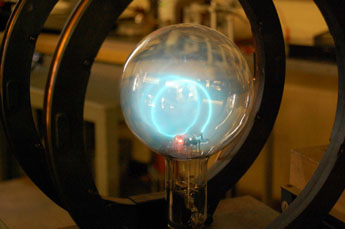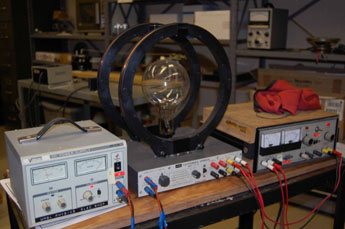

Order Demo
The PASCO e/m apparatus provides a simple method for measuring e/m, the charge to mass ratio of the electron. The method is similar to that used by J.J. Thomson in 1897. A beam of electrons is accelerated through a known potential, so the velocity of the electron is known. A pair of Helmholtz coils produces a uniform and measurable magnetic field at right angles to the electron beam. This magnetic field deflects the electron beam in a circular path. By measuring the accelerating potential (V), the current in the Helmholtz coils (I), and the radius of the circular path of the electron beam (r), e/m is easily calculated: e/m = 2V/(B^2*r^ 2). (The calculations are explained in the Operation section of the instruction manual.)
The e/m apparatus also has deflection plates that can be used to demonstrate the effect of an electric field on the electron beam. This can be used as a confirmation of the negative charge of the electron, and also to demonstrate how an oscilloscope works.
A unique feature of the e/m tube is that the socket rotates, allowing the electron beam to be oriented at any angle (from 0-90 degrees) with respect to the magnetic field from the Helmholtz coils. You can therefore rotate the tube and examine the vector nature of the magnetic forces on moving charged particles. Other experiments are also possible with the e/m tube. For example, you can use a small permanent magnet instead of the Helmholtz coils to investigate the effect of a magnetic field on the electron beam.